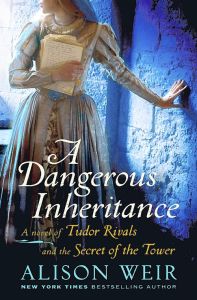‘A Dangerous Inheritance’ by Alison Weir
Historical fiction is always a strange genre – combining elements of the truth from important historical events and embellishing them until they are almost unrecognisable. Whilst reading Alison Weir’s ‘A Dangerous Inheritance’, I had to repeatedly come to terms with the fact that this was a captivating murder mystery fiction, but based on shady characters and missing children that were all too real.
The story follows two protagonist separated by almost 80 years and connected only by a mystery that they are both desperate to solve, each for her own personal reasons. Weir does an excellent job of encapsulating the brutal and oppressive nature of 15th and 16th century life, constantly reminding me of how lucky I am to be born in this era, and not one in which I could legally lose my head for the smallest of misdemeanours and in which I could be married off at twelve years old purely to advance my family’s political interests.
The author seamlessly weaves together two quite unconnected but famous stories in English history – the tale of the missing princes in the tower and the tragic story of Lady Jane Grey, the ill-fated nine-day queen. The story is written as though by Jane’s sister, Katherine Grey, and switches occasionally to chapters told in the third person, which tell the story of Katherine Plantagenet, the illegitimate daughter of King Richard III. The novel follows her desperate (but probably fictional) attempts to prove that her father did not murder his nephews, as everyone at the time was inclined to believe.
It is a good concept, but the similarity of their names made it difficult to remember which Katherine I was reading at any one time. It only took a second or two to think it through each time, but this conscious thought slowed me down enough to sometimes detract from the enjoyment of the book. I’ve been told that the cardinal sin of any writer is to pick names that are the same or too similar, and now I can see why, although I suppose in this case it isn’t her fault – they were real women after all.
Both stories are tragic. Grey watches most of her family members fall from grace and perish all around her, and is thrown into a world of political intrigue, cursed by her royal blood. Speaking of royalty, it was nice to see a change from the usual portrayal of Grey’s cousin, Elizabeth I, in this story. Normally hailed as the 16th century’s answer to feminism and strong leadership against the odds, she comes across as petty, spiteful, and immature throughout the entirety of Katherine’s account. I was previously unaware of the close familial relationship between the Greys and the Tudors, and so it was interesting to learn in a bit more detail the almost incestuous nature of the noble families at that time.
Plantagenet’s story is also tragic, but was also one to be taken with a huge bucket of salt. Actual historical information about this historical figure is so sparse as to be almost non-existent, and so her story is for the most part entirely fictional, aside from the bare, bare facts.
 The story follows Plantagenet from her happy home life with her royal father and his wife, to her unhappy marriage to a nobleman, and dangerous love affair with her cousin. Whilst trying to discover what happened to the princes, who have never been found even to this day, she writes down her treasonous thoughts (as by this time Henry II was now king, having defeated Richard at the battle of Bosworth), which were to be found almost a century later by Katherine Grey, who continues where Plantagenet left off.
The story follows Plantagenet from her happy home life with her royal father and his wife, to her unhappy marriage to a nobleman, and dangerous love affair with her cousin. Whilst trying to discover what happened to the princes, who have never been found even to this day, she writes down her treasonous thoughts (as by this time Henry II was now king, having defeated Richard at the battle of Bosworth), which were to be found almost a century later by Katherine Grey, who continues where Plantagenet left off.
It was a captivating mystery, but slightly marred by the fact that I knew neither of them were going to get to the bottom of it. Knowing the ending is always going to ruin a book slightly, which is the unavoidable problem with historical fiction.
The family trees at the beginning of the book were incredibly interesting, and also essential, as otherwise I would have been completely lost with the seemingly endless amounts of Richards, Henrys, and Edwards that proliferated at the time. It was also highly useful to have the chapter at the end written by Weir, who separates the fiction from the fact for the reader who does not hold a degree in Royal History.
All-in-all, I was impressed. Weir did not get too bogged down in trying to provide an accurate historical account and took the artistic licence far enough to create a highly engaging story but not so far that she lost the spirit and societal parameters of the time. In short: an enjoyable read.

